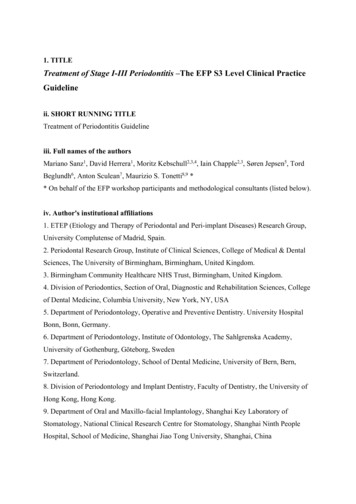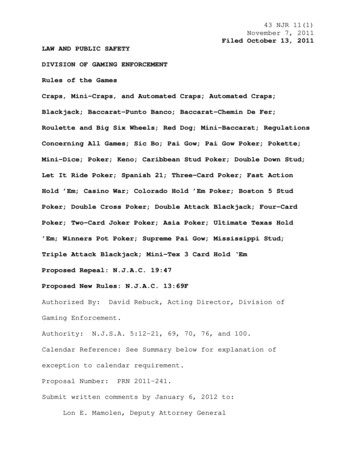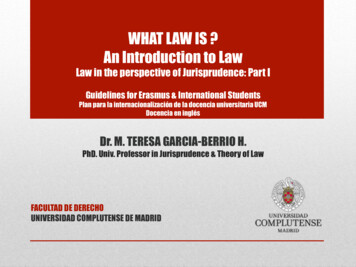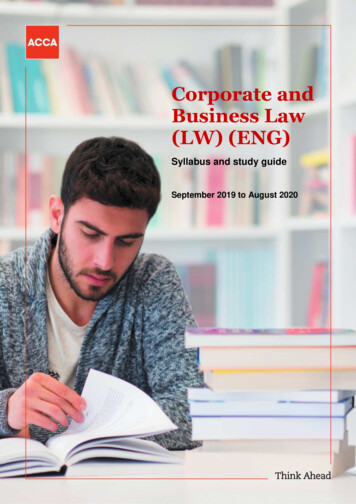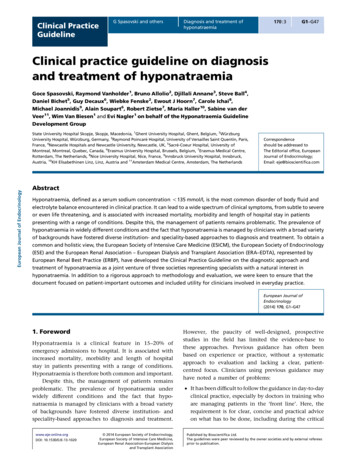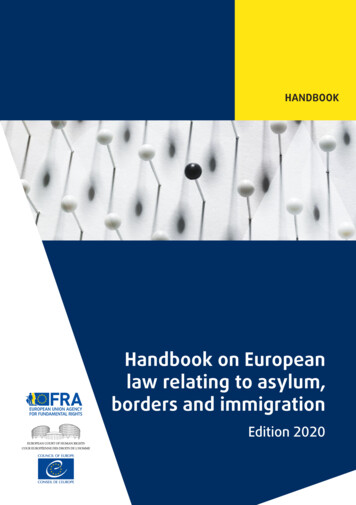
Transcription
HANDBOOKHandbook on Europeanlaw relating to asylum,borders and immigrationEdition 2020
The manuscript for the third edition of this handbook was completed in July 2020. It was originallypublished in five languages in December 2020. This third edition incorporates the changes to theEU acquis in the field of asylum, borders and immigration, as well as developments in Europeancase law since 2014. The first edition was published in four languages in 2013, followed by thesecond edition in 2014. Future updates of this handbook will become available on the EuropeanUnion Agency for Fundamental Rights (FRA) webpage at: ers and on the European Court of Human Rights (ECtHR) webpage at: www.echr.coe.intunder ‘Publications’.Reproduction is authorised, except for commercial purposes, provided the source is acknowledged.Photo credit (cover & inside): iStockphoto European Union Agency for Fundamental Rights and Council of Europe, 2020For any use or reproduction of photos or other material that is not under the European Union Agencyfor Fundamental Rights/Council of Europe copyright, permission must be sought directly from thecopyright holders.Neither the European Union Agency for Fundamental Rights/Council of Europe nor any person actingon behalf of the European Union Agency for Fundamental Rights/Council of Europe is responsiblefor the use that might be made of the following information.Luxembourg: Publications Office of the European Union, 2020Council of Europe: ISBN 978-92-871-9800-6FRA – print:ISBN 978-92-9474-985-7FRA – web:ISBN 51TK-02-20-493-EN-CTK-02-20-493-EN-NThis handbook was drafted in English. The ECtHR takes no responsibility for the quality of thetranslations into other languages. The views expressed in this handbook do not bind the ECtHR. Thehandbook refers to a selection of commentaries and manuals. The ECtHR takes no responsibilityfor their content, nor does their inclusion on this list amount to any form of endorsement of thesepublications. Further publications are listed on the internet pages of the ECtHR library at: echr.coe.int.
Handbook on European lawrelating to asylum, bordersand immigrationEdition 2020
ForewordSince 2011, the European Union (EU) Agency for Fundamental Rights, the Councilof Europe and the European Court of Human Rights, have published handbooks onvarious fields of European law. This handbook provides an overview of the Europeanlegal standards relevant to asylum, borders and immigration, explaining both applicable Council of Europe and EU measures.The handbook is intended for lawyers, judges, prosecutors, border guards, immigration officials and others working with national authorities, as well as national humanrights institutions, non-governmental organisations and other bodies that may beconfronted with legal questions in the areas covered.The Charter of Fundamental Rights of the EU became legally binding when the Lisbon Treaty entered into force in December 2009. It has the same legal value as thefounding EU Treaties. The Lisbon Treaty also provides for EU accession to the European Convention on Human Rights, which is legally binding on all Member States ofthe EU and the Council of Europe.Since we published the second edition of this handbook in 2014, there have beensignificant developments in European law relating to asylum, borders and immigration. For example, a number of adopted EU instruments upgrade or establish newlarge-scale EU information technology systems to manage migration. There havealso been smaller legislative changes – for instance, in the Schengen acquis on borders, irregular migration and visas.Similarly, the Court of Justice of the EU has clarified several legal questions emergingfrom the implementation of EU migration and asylum law in its ever-expanding caselaw. The European Court of Human Rights has also delivered a number of importantjudgments, notably in the area of reception conditions of asylum seekers. In light ofsuch changes, the handbook required an update to ensure that its legal guidanceremains accurate.3
Handbook on European law relating to asylum, borders and immigrationImproving the understanding of common principles developed in the case law of thetwo European courts, and in EU regulations and directives, is essential. Such understanding helps ensure that relevant European standards and safeguards are properlyimplemented and fundamental rights fully respected at national level. We hope thishandbook will help to promote this important objective.4Marialena TsirliMichael O’FlahertyRegistrar of the European Courtof Human RightsDirector of the European Union Agencyfor Fundamental Rights
ContentsFOREWORD.3ABBREVIATIONS. 11HOW TO USE THIS HANDBOOK. 14INTRODUCTION . 19The Council of Europe . 19The European Union . 21The Charter of Fundamental Rights of the European Union . 25European Union accession to the European Convention on Human Rights . 26Key points . 271 ACCESS TO THE TERRITORY AND TO PROCEDURES . 29Introduction . 301.1. The Schengen visa regime . 321.2. Preventing unauthorised entry . 351.3. Entry bans and Schengen alerts . 361.4. Checks at border-crossing points . 391.5. Internal borders within the Schengen area . 401.6. Local border traffic . 411.7. Transit zones . 431.8. Access to asylum . 441.9. Push-backs and pull-backs at sea . 46Key points . 482 LARGE-SCALE EU INFORMATION TECHNOLOGY SYSTEMSAND INTEROPERABILITY . 49Introduction . 512.1. Large-scale EU information systems . 522.1.1.2.1.2.2.1.3.2.1.4.2.1.5.2.1.6.European Asylum Dactyloscopy (Eurodac) .53Visa Information System (VIS) .53Schengen Information System (SIS) .54Entry/Exit System (EES) .55European Travel Authorisation and Information System (ETIAS) .56European Criminal Records Information System on Third-CountryNationals (ECRIS-TCN) .562.1.7. Europol Information System (EIS) .575
Handbook on European law relating to asylum, borders and .2.4. 59Common Identity Repository .60European Search Portal .61Multiple-Identity Detector .61Shared Biometric Matching Service .612.3. Oversight . 622.4. Purpose limitation, data minimisation and data accuracy . 632.5. Right to information . 662.6Access to data . 692.7. Data transfers to third parties . 722.8. Data subjects’ rights . 73Key points . 763 STATUS AND ASSOCIATED DOCUMENTATION . 79Introduction . 803.1. Asylum seekers . 813.2. Recognised refugees and those recognised as being in needof subsidiary protection . 833.3. Victims of trafficking and of particularly exploitative labourconditions . 843.4. Persons affected by Rule 39 interim measures . 863.5. Migrants in an irregular situation . 873.6. Long-term residents . 903.7. Turkish nationals . 923.8. British nationals . 953.9. Third-country nationals who are family members of EEAor Swiss nationals . 963.10. Stateless persons and the loss of citizenship or documentation . 97Key points . 994 ASYLUM DETERMINATION AND BARRIERS TO REMOVAL:SUBSTANTIVE ISSUES . 101Introduction . 1044.1. The right to asylum and the principle of non-refoulement . .6The nature of the risk under EU law .108The nature of the risk under the ECHR .111Assessment of risk .117Sufficiency of protection .120Internal relocation .123Safety elsewhere .124Exclusion from international protection .127Cessation of international protection .129
Contents4.2.4.3.4.4.Collective expulsion . 131Barriers to expulsion based on other human rights grounds . 133Third-country nationals who enjoy a higher degreeof protection from removal . 1354.4.1. Long-term residents .1364.4.2. Third-country national family members of EEA and Swiss nationals .1364.4.3 Turkish nationals .138Key points. 1395 PROCEDURAL SAFEGUARDS AND LEGAL SUPPORT IN ASYLUMAND RETURN CASES . 141Introduction . 1425.1. Asylum procedures . ew, examination procedure and initial decision-making .143Right to an effective remedy .146Appeals with automatic suspensive effect .149Accelerated asylum procedures .152Dublin procedure . 153Procedures relating to reception conditions of asylum seekers . 159Return procedures . 159Legal assistance in asylum and return procedures . 1625.5.1. Legal assistance in asylum procedures .1645.5.2. Legal assistance in return procedures .1645.5.3. Legal assistance to challenge reception conditionsKey points.165. 1666 PRIVATE AND FAMILY LIFE AND THE RIGHT TO MARRY . 167Introduction . 1696.1. The right to marry and to found a family . 1716.2. Family regularisation . 1736.3. Family reunification . 1826.4. Maintaining the family – protection from expulsion . 1886.4.1. Relationship breakdown .1886.4.2. Criminal convictions .189Key points. 1937 DETENTION AND RESTRICTIONS TO FREEDOM OF MOVEMENT . 195Introduction . 1987.1. Deprivation of liberty or restriction on the freedom ofmovement? . 1997.2. Alternatives to detention . 2017
Handbook on European law relating to asylum, borders and immigration7.3.Exhaustive list of exceptions to the right to liberty. 2037.3.1. Detention to prevent an unauthorised entry into the country .2067.3.2. Detention pending removal or extradition .2087.4.7.5.7.6.Prescribed by law . 211Necessity and proportionality . 212Arbitrariness . 2137.6.1.7.6.2.7.6.3.7.6.4.7.7.7.8.Good faith .214Due diligence .215Realistic prospect of removal .216Maximum length of detention .218Detention of individuals with specific needs . 220Procedural safeguards . 2237.8.1. Right to be given reasons .2237.8.2. Right to review of detention .2257.9. Detention conditions or regimes . 2277.10. Compensation for unlawful detention . 230Key points . 2318 FORCED RETURNS AND MANNER OF REMOVAL . 233Introduction . 2348.1. Carrying out removal: safe, dignified and humane . 2358.2. Confidentiality . 2368.3. Serious harm caused by restraint measures . 2378.4. Investigations . 240Key points . 2419 ECONOMIC AND SOCIAL RIGHTS . 243Introduction . 2459.1. Main sources of law . 2469.2. Economic rights . 2499.2.1.9.2.2.9.2.3.9.2.4.9.2.5.Family members of EEA and Swiss nationals .251Posted workers .252Blue Card holders, researchers and students .253Turkish nationals .254Long-term residents and beneficiaries of the Family ReunificationDirective .2559.2.6. Nationals of other countries with association or cooperationagreements .2569.2.7. Asylum seekers and refugees .2599.2.8. Migrants in an irregular situation .2608
Contents9.3. Education . 2609.4. Housing . 2639.5. Healthcare . 2699.6. Social security and social assistance . 272Key points . 27710 PERSONS WITH SPECIFIC NEEDS . 281Introduction . 28210.1. Unaccompanied children . 28310.1.1. Reception and treatment .28410.1.2. Age assessment .28710.2. Victims of trafficking in human beings . 28910.3. Persons with disabilities . 29110.4. Victims of torture . 29210.5. Victims of gender-based violence . 294Key points . 296FURTHER READINGONLINE SOURCESLIST OF CASES. 297. 305. 309HOW TO FIND CASE LAW OF THE EUROPEAN COURTSEU INSTRUMENTS AND SELECTED AGREEMENTS. 329. 335ANNEX 1: APPLICABILITY OF EU REGULATIONS AND DIRECTIVES CITEDIN THIS HANDBOOK .345ANNEX 2: APPLICABILITY OF SELECTED COUNCIL OF EUROPE INSTRUMENTSANNEX 3: ACCEPTANCE OF ESC PROVISIONS.352.355ANNEX 4: ACCEPTANCE OF SELECTED UN CONVENTIONSANNEX 5: COUNTRY CODES USED IN THE ANNEXES.359.3619
AbbreviationsACPAfrican, Caribbean and PacificBMSshared Biometric Matching ServiceCATUnited Nations Convention Against TortureCETSCouncil of Europe Treaty SeriesCIRCommon Identity RepositoryCJEUCourt of Justice of the European Union (prior to December2009, European Court of Justice)CoECouncil of EuropeCRCUnited Nations Convention on the Rights of the ChildCRPDUnited Nations Convention on the Rights of Persons withDisabilitiesCPTEuropean Committee for the Prevention of Torture andInhuman or Degrading Treatment or PunishmentDPAData protection authorityEASOEuropean Asylum Support OfficeFrontexEuropean Border and Coast Guard AgencyECHREuropean Convention on Human RightsECtHREuropean Court of Human RightsECJEuropean Court of Justice (since December 2009, Court ofJustice of the European Union)ECRIS-TCNEuropean Criminal Records Information System on ThirdCountry NationalsECSREuropean Committee of Social RightsEDPSEuropean Data Protection SupervisorEEAEuropean Economic Area11
Handbook on European law relating to asylum, borders and immigration12EEA nationalsNationals of one of the 27 EU Member States, Iceland,Liechtenstein and NorwayEECEuropean Economic CommunityEESEntry/Exit SystemEFTAEuropean Free Trade AssociationEISEuropol Information Sy
from the implementation of EU migration and asylum law in its ever-expanding case law. The European Court of Human Rights has also delivered a number of important judgments, notably in the area of reception conditions of asylum seekers. In light of such changes, the handbook required an update to ensure that its legal guidance remains accurate.



